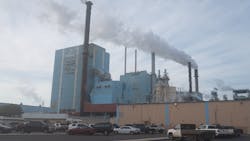Massive Paper Pulp Mill in Arkansas Aiming to Capture 1.5M Metric Tons of Carbon
One of the nation’s biggest paper pulp mills will install carbon capture and storage targeting up to 1.5 million metric tons of biogenic CO2.
Svante Technologies will develop the CCS project at the Ashdown Pulp Mill facility in Arkansas. Ashdown, owned by Domtar-Paper Excellence, produces close to 775,000 air dry metric tons of pulp annually, according to the parent company.
The project will help deploy Svante’s carbon capture technology for the pulp and paper industry to generate carbon dioxide removal (CDR) credits and enhance the sustainability of the industry’s operations. The project has been selected by the U.S. Department of Energy's (DOE) Industrial Efficiency and Decarbonization Office (IEDO) for negotiation of a cost-sharing agreement of up to almost $1.5 million.
“The pulp and paper industry represents a unique opportunity for technology and nature to work in tandem to remove CO2 from the atmosphere,” said Claude Letourneau, President & CEO of Svante, in a statement. “Svante's MOF-based carbon capture technology has the potential to revolutionize how industrial facilities manage their emissions, and we are confident that this project will pave the way for wider industry adoption.”
Microsoft, Akers & Partners Aim
for Carbon Capture in Paper Mills
Paper Excellence in Wood and Svante will partner in conducting a preliminary front end engineering and design study to evaluate post-combustion carbon capture from the recovery boilers’ flue gas at the Ashdown pulp mill.
As the project reaches final investment decision (FID), it could help the mill remove tons of CO2, create new revenue steams through CO2 removal credits and advance CCS technology in the pulp and paper sector. More than 200 pulp and paper production sites generate close to 35 million metric tons of CO2 equivalent annually, according to federal emissions statistics.
Domtar was acquired by Paper Excellence Group in 2021 and acts as a subsidiary. It manufactures wood pulp and paper products through facilities in Quebec, Ontario, British Columbia, Kentucky, South Carolina, Tennessee and Arkansas. The facility was shut down for a time but brought back online in 2021.
About a decade ago, Domtar announced it was investing $160 million to convert the Ashdown mill’s paper machine into a fluff pulp line. Fluff pulp is a type of chemical pulp made from fiber softwoods and used in the absorbent core of products such as diapers and other hygiene napkins.
From NA+ to Volcanic Geothermal: Innovations in Power
Check out our new EnergyTech E-Book
About the Author
Rod Walton, EnergyTech Managing Editor
Managing Editor
For EnergyTech editorial inquiries, please contact Managing Editor Rod Walton at [email protected].
Rod Walton has spent 17 years covering the energy industry as a newspaper and trade journalist. He formerly was energy writer and business editor at the Tulsa World. Later, he spent six years covering the electricity power sector for Pennwell and Clarion Events. He joined Endeavor and EnergyTech in November 2021.
Walton earned his Bachelors degree in journalism from the University of Oklahoma. His career stops include the Moore American, Bartlesville Examiner-Enterprise, Wagoner Tribune and Tulsa World.
EnergyTech is focused on the mission critical and large-scale energy users and their sustainability and resiliency goals. These include the commercial and industrial sectors, as well as the military, universities, data centers and microgrids. The C&I sectors together account for close to 30 percent of greenhouse gas emissions in the U.S.
He was named Managing Editor for Microgrid Knowledge and EnergyTech starting July 1, 2023
Many large-scale energy users such as Fortune 500 companies, and mission-critical users such as military bases, universities, healthcare facilities, public safety and data centers, shifting their energy priorities to reach net-zero carbon goals within the coming decades. These include plans for renewable energy power purchase agreements, but also on-site resiliency projects such as microgrids, combined heat and power, rooftop solar, energy storage, digitalization and building efficiency upgrades.

